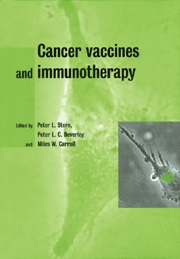Book contents
- Frontmatter
- Contents
- List of contributors
- 1 Immunity and cancer
- 2 Immunotherapy of bladder cancer
- 3 Poxviruses as vectors for cancer immunotherapy
- 4 Vaccinia-based human papillomavirus vaccines in cervical cancer
- 5 Vaccine delivery and immunosuppression in cervical cancer
- 6 Vaccines for colon cancer
- 7 MUC1 vaccines and breast cancer
- 8 Anti-idiotypic vaccination
- 9 Immunotherapy and vaccination against Epstein–Barr virus-associated cancer
- 10 Serologically identified tumour antigens as cancer vaccines
- 11 CTL-defined cancer vaccines in melanoma and other epithelial cancers
- 12 DNA vaccines against B-cell tumours
- 13 Dendritic cell approaches to immunotherapy
- 14 Overview
- 15 Recent developments
- Index
12 - DNA vaccines against B-cell tumours
Published online by Cambridge University Press: 06 January 2010
- Frontmatter
- Contents
- List of contributors
- 1 Immunity and cancer
- 2 Immunotherapy of bladder cancer
- 3 Poxviruses as vectors for cancer immunotherapy
- 4 Vaccinia-based human papillomavirus vaccines in cervical cancer
- 5 Vaccine delivery and immunosuppression in cervical cancer
- 6 Vaccines for colon cancer
- 7 MUC1 vaccines and breast cancer
- 8 Anti-idiotypic vaccination
- 9 Immunotherapy and vaccination against Epstein–Barr virus-associated cancer
- 10 Serologically identified tumour antigens as cancer vaccines
- 11 CTL-defined cancer vaccines in melanoma and other epithelial cancers
- 12 DNA vaccines against B-cell tumours
- 13 Dendritic cell approaches to immunotherapy
- 14 Overview
- 15 Recent developments
- Index
Summary
Introduction
There are tantalizing glimpses of the intrinsic ability of the human immune system to control emerging cancer cells. This is seen most clearly in EBV-associated B-cell tumours which emerge in patients undergoing immunosuppression following organ transplantation. Humoral immune responses against tumour antigens of melanoma and of epithelial malignancies have also been detected in patients. However, when patients have cancer, the tumour cells have obviously evaded any immunological weapons. Vaccination as a treatment has to be able to activate a defeated immune system, in a situation where tumour antigens may still be present, and where the patient may be debilitated by disease or treatment.
Tumours of B lymphocytes are attractive for study because of the availability of cells, and because of an increasing understanding of the array of potential target molecules expressed at the cell surface. There is also a clinical need to develop new treatments for the many categories for which chemotherapy has not improved survival. However, these tumours exist despite exposure to the full power of the immune system. If we can succeed in activating an antitumour response against B-cell tumours, therefore, we should be in a strong position to attack other cancers which are less exposed. Molecular technology is facilitating vaccine development in three ways: first, by revealing novel tumour antigens; second, by aiding our understanding of immune mechanisms; and third, by facilitating new delivery systems to mobilize those mechanisms.
This review will focus on malignancies arising from B lymphocytes.
- Type
- Chapter
- Information
- Cancer Vaccines and Immunotherapy , pp. 218 - 236Publisher: Cambridge University PressPrint publication year: 2000



